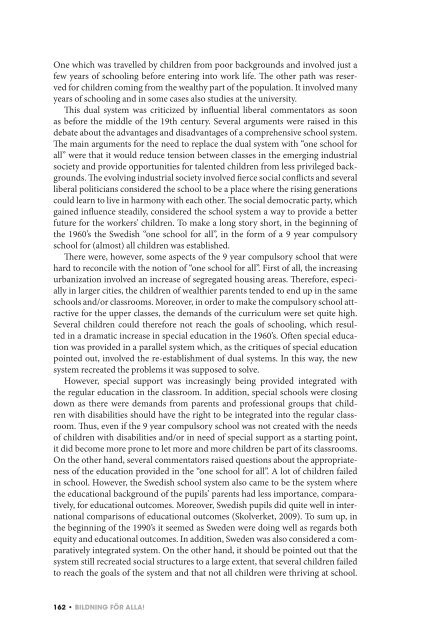Bildning för alla! - DiVA
Bildning för alla! - DiVA
Bildning för alla! - DiVA
You also want an ePaper? Increase the reach of your titles
YUMPU automatically turns print PDFs into web optimized ePapers that Google loves.
One which was travelled by children from poor backgrounds and involved just a<br />
few years of schooling before entering into work life. The other path was reserved<br />
for children coming from the wealthy part of the population. It involved many<br />
years of schooling and in some cases also studies at the university.<br />
This dual system was criticized by influential liberal commentators as soon<br />
as before the middle of the 19th century. Several arguments were raised in this<br />
debate about the advantages and disadvantages of a comprehensive school system.<br />
The main arguments for the need to replace the dual system with “one school for<br />
all” were that it would reduce tension between classes in the emerging industrial<br />
society and provide opportunities for talented children from less privileged backgrounds.<br />
The evolving industrial society involved fierce social conflicts and several<br />
liberal politicians considered the school to be a place where the rising generations<br />
could learn to live in harmony with each other. The social democratic party, which<br />
gained influence steadily, considered the school system a way to provide a better<br />
future for the workers’ children. To make a long story short, in the beginning of<br />
the 1960’s the Swedish “one school for all”, in the form of a 9 year compulsory<br />
school for (almost) all children was established.<br />
There were, however, some aspects of the 9 year compulsory school that were<br />
hard to reconcile with the notion of “one school for all”. First of all, the increasing<br />
urbanization involved an increase of segregated housing areas. Therefore, especially<br />
in larger cities, the children of wealthier parents tended to end up in the same<br />
schools and/or classrooms. Moreover, in order to make the compulsory school attractive<br />
for the upper classes, the demands of the curriculum were set quite high.<br />
Several children could therefore not reach the goals of schooling, which resulted<br />
in a dramatic increase in special education in the 1960’s. Often special education<br />
was provided in a parallel system which, as the critiques of special education<br />
pointed out, involved the re-establishment of dual systems. In this way, the new<br />
system recreated the problems it was supposed to solve.<br />
However, special support was increasingly being provided integrated with<br />
the regular education in the classroom. In addition, special schools were closing<br />
down as there were demands from parents and professional groups that children<br />
with disabilities should have the right to be integrated into the regular classroom.<br />
Thus, even if the 9 year compulsory school was not created with the needs<br />
of children with disabilities and/or in need of special support as a starting point,<br />
it did become more prone to let more and more children be part of its classrooms.<br />
On the other hand, several commentators raised questions about the appropriateness<br />
of the education provided in the “one school for all”. A lot of children failed<br />
in school. However, the Swedish school system also came to be the system where<br />
the educational background of the pupils’ parents had less importance, comparatively,<br />
for educational outcomes. Moreover, Swedish pupils did quite well in international<br />
comparisons of educational outcomes (Skolverket, 2009). To sum up, in<br />
the beginning of the 1990’s it seemed as Sweden were doing well as regards both<br />
equity and educational outcomes. In addition, Sweden was also considered a comparatively<br />
integrated system. On the other hand, it should be pointed out that the<br />
system still recreated social structures to a large extent, that several children failed<br />
to reach the goals of the system and that not all children were thriving at school.<br />
162 • BilDning fÖr AllA!

















